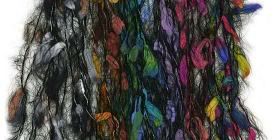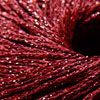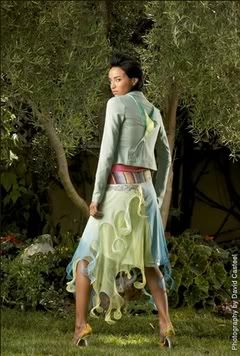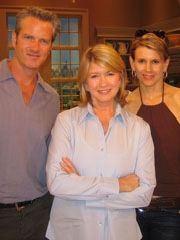Dear, oh, dear.
The Empress of Green has been on holiday for quite a while — but the Empire of Green will be back in the next few weeks, just in time to bring you eco-fashionable infobytes for the 2011 holiday season.
Keep those eco-peepers peeled, dears! And if you don't want to miss Our re-launch, subscribe to get new posts by e-mail (in that nice little box at the top of the right-hand column), or add yourself to our shiny new followers list by clicking the blue "Join this site" button on the right.
See you again soon, green-hearted lovelies!
Green Empress, Patroness of Eco-chic
Infobytes for the eco-chic, compassionately conscious Renaissance consumer of the twenty-first century
Tuesday, October 18, 2011
Sunday, December 04, 2005
Treehuggers might be wearing 'em
The trees, that is.
 Ever wonder what "viscose" is? It's actually the original name for rayon, which is a polymer made from cellulose, a.k.a. wood pulp. It's like plastic, but made from plants instead of petroleum -- which sounds pretty good, eh? That's why Her Imperial Greenness has sometimes called it "the non-evil plastic." But beware: the manufacturing process for rayon is water- and energy-intense, and contributes to air and water pollution. And you may have noticed it already, but yes, it's made from wood pulp, and that means cutting down trees -- so rayon production contributes to deforestation if its manufacturers aren't environmentally aware enough to manage resources and plant new trees.
Ever wonder what "viscose" is? It's actually the original name for rayon, which is a polymer made from cellulose, a.k.a. wood pulp. It's like plastic, but made from plants instead of petroleum -- which sounds pretty good, eh? That's why Her Imperial Greenness has sometimes called it "the non-evil plastic." But beware: the manufacturing process for rayon is water- and energy-intense, and contributes to air and water pollution. And you may have noticed it already, but yes, it's made from wood pulp, and that means cutting down trees -- so rayon production contributes to deforestation if its manufacturers aren't environmentally aware enough to manage resources and plant new trees.
Regardless of its evilness content, rayon is made from plant material, and therefore behaves rather more like other plant fibers (like cotton and linen) than like other polymers. It's absorbent, soft, easy to dye (that means it has super bright color potential!), and has an ooh-la-la drape. But that's only logical -- it was first created as a "man-made silk." It also breathes well and doesn't produce static. It does wrinkle, but that's what irons and the shower trick are for; and it doesn't stretch very well, and is particularly weak when wet.
As polymers go, rayon is one fairly tolerable polymer. Now, if we can clean up that manufacturing process...
 Ever wonder what "viscose" is? It's actually the original name for rayon, which is a polymer made from cellulose, a.k.a. wood pulp. It's like plastic, but made from plants instead of petroleum -- which sounds pretty good, eh? That's why Her Imperial Greenness has sometimes called it "the non-evil plastic." But beware: the manufacturing process for rayon is water- and energy-intense, and contributes to air and water pollution. And you may have noticed it already, but yes, it's made from wood pulp, and that means cutting down trees -- so rayon production contributes to deforestation if its manufacturers aren't environmentally aware enough to manage resources and plant new trees.
Ever wonder what "viscose" is? It's actually the original name for rayon, which is a polymer made from cellulose, a.k.a. wood pulp. It's like plastic, but made from plants instead of petroleum -- which sounds pretty good, eh? That's why Her Imperial Greenness has sometimes called it "the non-evil plastic." But beware: the manufacturing process for rayon is water- and energy-intense, and contributes to air and water pollution. And you may have noticed it already, but yes, it's made from wood pulp, and that means cutting down trees -- so rayon production contributes to deforestation if its manufacturers aren't environmentally aware enough to manage resources and plant new trees.Regardless of its evilness content, rayon is made from plant material, and therefore behaves rather more like other plant fibers (like cotton and linen) than like other polymers. It's absorbent, soft, easy to dye (that means it has super bright color potential!), and has an ooh-la-la drape. But that's only logical -- it was first created as a "man-made silk." It also breathes well and doesn't produce static. It does wrinkle, but that's what irons and the shower trick are for; and it doesn't stretch very well, and is particularly weak when wet.
As polymers go, rayon is one fairly tolerable polymer. Now, if we can clean up that manufacturing process...
Thursday, November 17, 2005
Help! There's a polyamide in my sweater!
On the theme of fibers with inexplicable names (though this season the Empress of Green has spotted yarns on the shelf labeled with -- gasp -- the impenetrable words "other fiber"; alas for full disclosure), shall we address polyamides? Why, let's.
Puzzle no longer over the perplexing term: polyamide simply means "nylon." All right, technically, the term "polyamide" refers to any "polymer containing repeating amide groups," and that includes natural fibers like wool and silk -- but at an Imperial Guess, clothing and yarn manufacturers would sooner put "wool" or "silk" on a label than "polyamide," so it's likely that "polyamide" in the context of fiber content labels is probably nylon, or some other plastic. (Kevlar is also a manufactured polyamide, if you prefer to think of your clothing as part Kevlar. Just don't 'spect your stunning forest-green cardigan to stop bullets.)
 Anyway, call it a thermoplastic polycondensate if you like (some do, believe it or not), but that strange word showing up on your clothing labels is another fancy name for plastic stuff. According to eFunda, polyamide is also used to make "high-lubricity parts," which, also according to them, somehow encompasses clothing fabric. (Shh. The "e" in "eFunda" stands for "engineering." They don't teach fashion design in engineering classes, last We checked ... Can't tell, can you?)
Anyway, call it a thermoplastic polycondensate if you like (some do, believe it or not), but that strange word showing up on your clothing labels is another fancy name for plastic stuff. According to eFunda, polyamide is also used to make "high-lubricity parts," which, also according to them, somehow encompasses clothing fabric. (Shh. The "e" in "eFunda" stands for "engineering." They don't teach fashion design in engineering classes, last We checked ... Can't tell, can you?)
Polyamide has a host of other uses, in car parts, electrical parts, construction, household equipment, and machinery, and is also applied to stuff (e.g., glass) as a thin film or a powder coating. It's super-abrasion-resistant, but the Imperial Instinct says that it's probably like other plastics: not very breathable. And as sayeth the illustrious Wikipedia, plastics may present the problem of outgassing, or giving off funny chemicals, which could bother chemically sensitive individuals. The Green Imperial Edict encourages simplicity: pass up anything labeled polyamide, and go for the good stuff. We'd rather spend Our money on organic cotton, anyway.
Puzzle no longer over the perplexing term: polyamide simply means "nylon." All right, technically, the term "polyamide" refers to any "polymer containing repeating amide groups," and that includes natural fibers like wool and silk -- but at an Imperial Guess, clothing and yarn manufacturers would sooner put "wool" or "silk" on a label than "polyamide," so it's likely that "polyamide" in the context of fiber content labels is probably nylon, or some other plastic. (Kevlar is also a manufactured polyamide, if you prefer to think of your clothing as part Kevlar. Just don't 'spect your stunning forest-green cardigan to stop bullets.)
 Anyway, call it a thermoplastic polycondensate if you like (some do, believe it or not), but that strange word showing up on your clothing labels is another fancy name for plastic stuff. According to eFunda, polyamide is also used to make "high-lubricity parts," which, also according to them, somehow encompasses clothing fabric. (Shh. The "e" in "eFunda" stands for "engineering." They don't teach fashion design in engineering classes, last We checked ... Can't tell, can you?)
Anyway, call it a thermoplastic polycondensate if you like (some do, believe it or not), but that strange word showing up on your clothing labels is another fancy name for plastic stuff. According to eFunda, polyamide is also used to make "high-lubricity parts," which, also according to them, somehow encompasses clothing fabric. (Shh. The "e" in "eFunda" stands for "engineering." They don't teach fashion design in engineering classes, last We checked ... Can't tell, can you?)Polyamide has a host of other uses, in car parts, electrical parts, construction, household equipment, and machinery, and is also applied to stuff (e.g., glass) as a thin film or a powder coating. It's super-abrasion-resistant, but the Imperial Instinct says that it's probably like other plastics: not very breathable. And as sayeth the illustrious Wikipedia, plastics may present the problem of outgassing, or giving off funny chemicals, which could bother chemically sensitive individuals. The Green Imperial Edict encourages simplicity: pass up anything labeled polyamide, and go for the good stuff. We'd rather spend Our money on organic cotton, anyway.
Wednesday, November 16, 2005
That funky mystery fiber, Lurex
 It's showing up all over this season, and maybe you're wondering: what the heck is this "Lurex" stuff? Sounds a little iffy to her Imperial Greenness, anyway. Here's the skinny: it's a trademarked name for a type of laboratory-produced yarn made of aluminum coated with plastic. Yum. So when you see it in a catalog or a clothing description, it means "man-made" (as if you couldn't tell from the name). It also means shiny or sparkly, since the metallic look's still in this season.
It's showing up all over this season, and maybe you're wondering: what the heck is this "Lurex" stuff? Sounds a little iffy to her Imperial Greenness, anyway. Here's the skinny: it's a trademarked name for a type of laboratory-produced yarn made of aluminum coated with plastic. Yum. So when you see it in a catalog or a clothing description, it means "man-made" (as if you couldn't tell from the name). It also means shiny or sparkly, since the metallic look's still in this season.Incidentally, Lurex is also the name of a mosquito attractant. Just a guess: this kind of Lurex probably won't show up on runways or in department stores unless the fashion world suddenly decides to start fighting the good fight on the hunt for the Asian Tiger Mosquito.
Friday, October 07, 2005
The shape of things to come is eco-friendly
 At least, that's what the Museum of Natural History said today, as part of a First Friday event held in collaboration with the "COLLAPSE?" exhibit.
At least, that's what the Museum of Natural History said today, as part of a First Friday event held in collaboration with the "COLLAPSE?" exhibit.Of particular interest to the eco-fashionista is this: the event featured a fashion show, tree-hugger style, in which models strutted earth-friendly couture from designers like Anna Mkhitarian, Kok Wai Wong, Elias Luna, and Petra Yates.
Apparently, the Museum of Natural History isn't just talking the past, these days -- it's talking about the future, and about solutions. If that attitude does shape things to come, the Empire of Green won't complain one bit.
Saturday, September 24, 2005
Linda Loudermilk serves up luxury, eco-flavored
Bamboo is the new cotton, says couturier Linda Loudermilk in an interview with the L.A. Times -- but from the looks of her designs, she was aiming too low. In her hands, bamboo might well be the new silk.
 Ms. Loudermilk uses exclusively exotic fibers like sasawashi, sea cell, and lenpur (a.k.a. wood pulp) as her canvas for creating beautiful clothes. But her work isn't about beauty first -- it's all about sustainability with a flair for the dramatic. That's why she's calling it "luxury eco" (that's a trademark, darlings). Straight from her web site, in as many words, her work screams: eco can be edgy. And on a Loudermilk runway (probably built of fast-growing supertropical bamboo, itself), there's little room for the serene hippie/Zen vibe many have come to associate with the organic movement. At least, We read from the aura of her web presence that she's rather more a proponent of the hollow-cheeked, long-necked, haughty model runway population. And in the organic world? That is edgy.
Ms. Loudermilk uses exclusively exotic fibers like sasawashi, sea cell, and lenpur (a.k.a. wood pulp) as her canvas for creating beautiful clothes. But her work isn't about beauty first -- it's all about sustainability with a flair for the dramatic. That's why she's calling it "luxury eco" (that's a trademark, darlings). Straight from her web site, in as many words, her work screams: eco can be edgy. And on a Loudermilk runway (probably built of fast-growing supertropical bamboo, itself), there's little room for the serene hippie/Zen vibe many have come to associate with the organic movement. At least, We read from the aura of her web presence that she's rather more a proponent of the hollow-cheeked, long-necked, haughty model runway population. And in the organic world? That is edgy.
By the by, do read the aforementioned L.A. Times article. It contains a smileworthy parcel of information on the Amazingly Sustainable Wonder Fiber: Bamboo.
 Ms. Loudermilk uses exclusively exotic fibers like sasawashi, sea cell, and lenpur (a.k.a. wood pulp) as her canvas for creating beautiful clothes. But her work isn't about beauty first -- it's all about sustainability with a flair for the dramatic. That's why she's calling it "luxury eco" (that's a trademark, darlings). Straight from her web site, in as many words, her work screams: eco can be edgy. And on a Loudermilk runway (probably built of fast-growing supertropical bamboo, itself), there's little room for the serene hippie/Zen vibe many have come to associate with the organic movement. At least, We read from the aura of her web presence that she's rather more a proponent of the hollow-cheeked, long-necked, haughty model runway population. And in the organic world? That is edgy.
Ms. Loudermilk uses exclusively exotic fibers like sasawashi, sea cell, and lenpur (a.k.a. wood pulp) as her canvas for creating beautiful clothes. But her work isn't about beauty first -- it's all about sustainability with a flair for the dramatic. That's why she's calling it "luxury eco" (that's a trademark, darlings). Straight from her web site, in as many words, her work screams: eco can be edgy. And on a Loudermilk runway (probably built of fast-growing supertropical bamboo, itself), there's little room for the serene hippie/Zen vibe many have come to associate with the organic movement. At least, We read from the aura of her web presence that she's rather more a proponent of the hollow-cheeked, long-necked, haughty model runway population. And in the organic world? That is edgy.By the by, do read the aforementioned L.A. Times article. It contains a smileworthy parcel of information on the Amazingly Sustainable Wonder Fiber: Bamboo.
Friday, September 23, 2005
Martha makes fur a no-no
Martha Stewart is using her super-fame to push more than the latest DIY cake decorations: she's paired with PETA to publicly denounce fur as cruel and unnecessary.
Her five-minute exposé on the cruelties of the fur industry is not for the faint of heart, but it may induce a change of heart, and viewers are encouraged to send it on to their family and friends. Propaganda? Possibly, though the video is a far cry from the highly-edited emotion-wringing idea We have of propaganda. Those who object to it as representing the industry unfairly should watch it, too -- and make a conscious decision whether furry fashions are really a fair trade-off for knowing animals may have been skinned alive to make them. (It's difficult to misrepresent someone who openly beats animals to death, is it not?)
Those who can still say they approve of the fur industry after watching Ms. Stewart's announcement had better be able to prove to Us that they have no pets -- or be branded hypocrites by the Official Seal of the Empire of Green, unless they're willing to admit their pets would be a worthy sacrifice to decorate someone's jacket collar.
 Ms. Stewart, on the other hand, wears the creed of the conscious consumer well. As she says in the video, "So much violence in the world seems beyond our control, but this is one cruelty we can stop by being informed consumers." And being an informed consumer can prevent a lot more, too: pointless waste and human cruelty among them.
Ms. Stewart, on the other hand, wears the creed of the conscious consumer well. As she says in the video, "So much violence in the world seems beyond our control, but this is one cruelty we can stop by being informed consumers." And being an informed consumer can prevent a lot more, too: pointless waste and human cruelty among them.
Designers that spurn the fur craze include Stella McCartney, Vivienne Westwood, Todd Oldham, and Marc Bouwer -- so if you buy designer, consider these stellar beings.
Here's star power used responsibly, and a perfect example of conscientious living. (Ms. Stewart's stint in prison, before anyone comments, is moot as far as Her Imperial Greenness is concerned. We don't judge people's worth by their rigid adherence to a legal system so convoluted it's probably made itself illegal.) Martha Stewart's got influence in her grasp, and in being aware of it, she's using it to change the world for the better.
Well, if Hollywood royalty just happens to catapult a compassionate, considered lifestyle into widespread popularity, that's one trend that'll definitely be worth following.
Her five-minute exposé on the cruelties of the fur industry is not for the faint of heart, but it may induce a change of heart, and viewers are encouraged to send it on to their family and friends. Propaganda? Possibly, though the video is a far cry from the highly-edited emotion-wringing idea We have of propaganda. Those who object to it as representing the industry unfairly should watch it, too -- and make a conscious decision whether furry fashions are really a fair trade-off for knowing animals may have been skinned alive to make them. (It's difficult to misrepresent someone who openly beats animals to death, is it not?)
Those who can still say they approve of the fur industry after watching Ms. Stewart's announcement had better be able to prove to Us that they have no pets -- or be branded hypocrites by the Official Seal of the Empire of Green, unless they're willing to admit their pets would be a worthy sacrifice to decorate someone's jacket collar.
 Ms. Stewart, on the other hand, wears the creed of the conscious consumer well. As she says in the video, "So much violence in the world seems beyond our control, but this is one cruelty we can stop by being informed consumers." And being an informed consumer can prevent a lot more, too: pointless waste and human cruelty among them.
Ms. Stewart, on the other hand, wears the creed of the conscious consumer well. As she says in the video, "So much violence in the world seems beyond our control, but this is one cruelty we can stop by being informed consumers." And being an informed consumer can prevent a lot more, too: pointless waste and human cruelty among them.Designers that spurn the fur craze include Stella McCartney, Vivienne Westwood, Todd Oldham, and Marc Bouwer -- so if you buy designer, consider these stellar beings.
Here's star power used responsibly, and a perfect example of conscientious living. (Ms. Stewart's stint in prison, before anyone comments, is moot as far as Her Imperial Greenness is concerned. We don't judge people's worth by their rigid adherence to a legal system so convoluted it's probably made itself illegal.) Martha Stewart's got influence in her grasp, and in being aware of it, she's using it to change the world for the better.
Well, if Hollywood royalty just happens to catapult a compassionate, considered lifestyle into widespread popularity, that's one trend that'll definitely be worth following.
Subscribe to:
Posts (Atom)